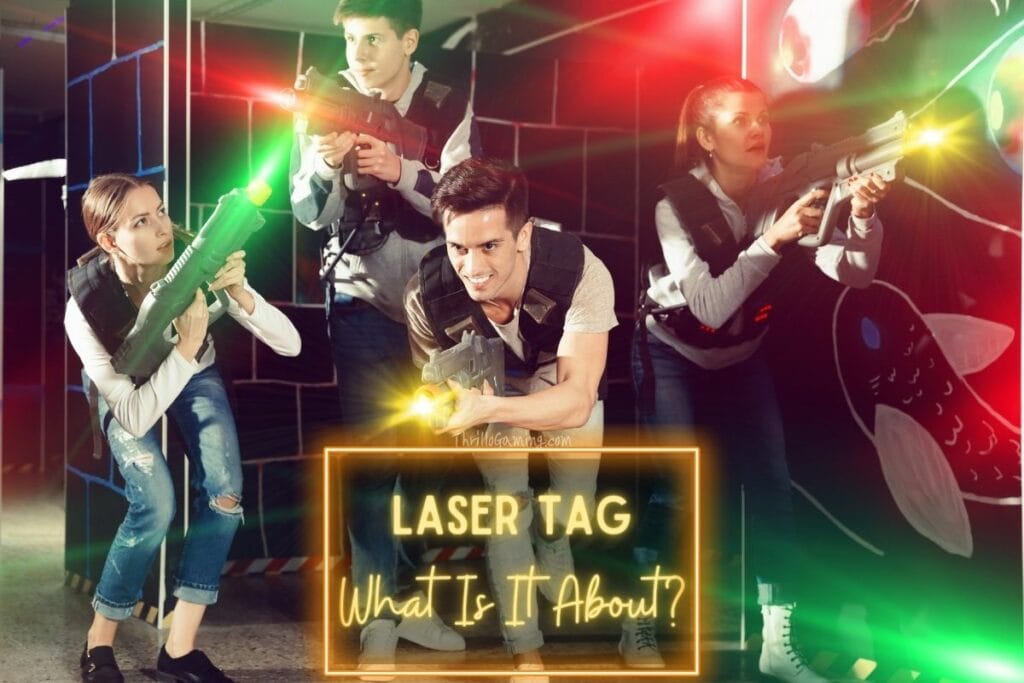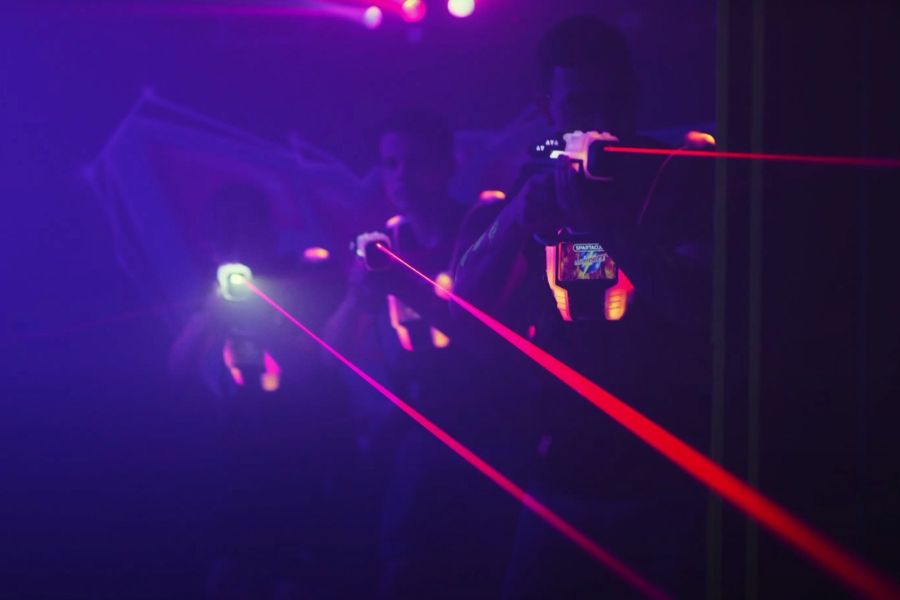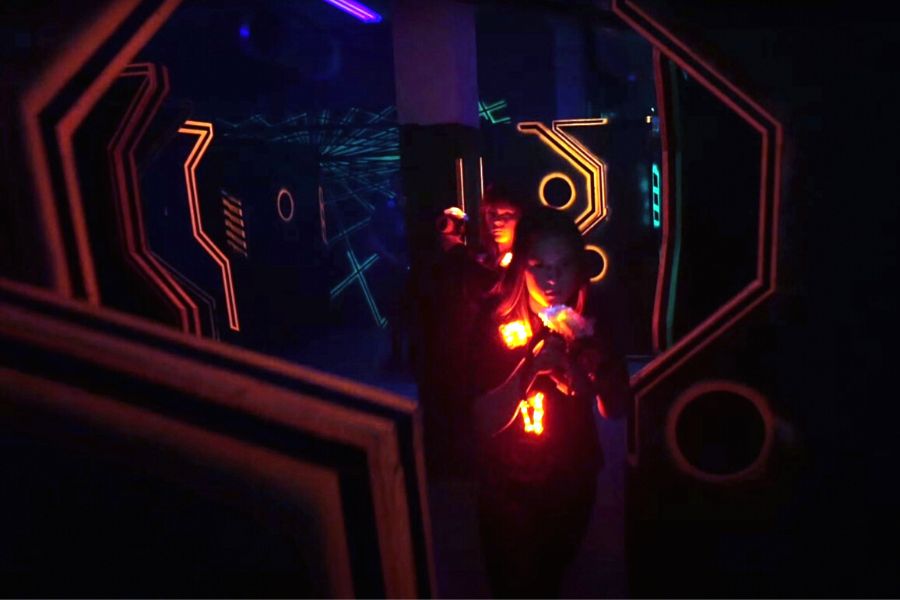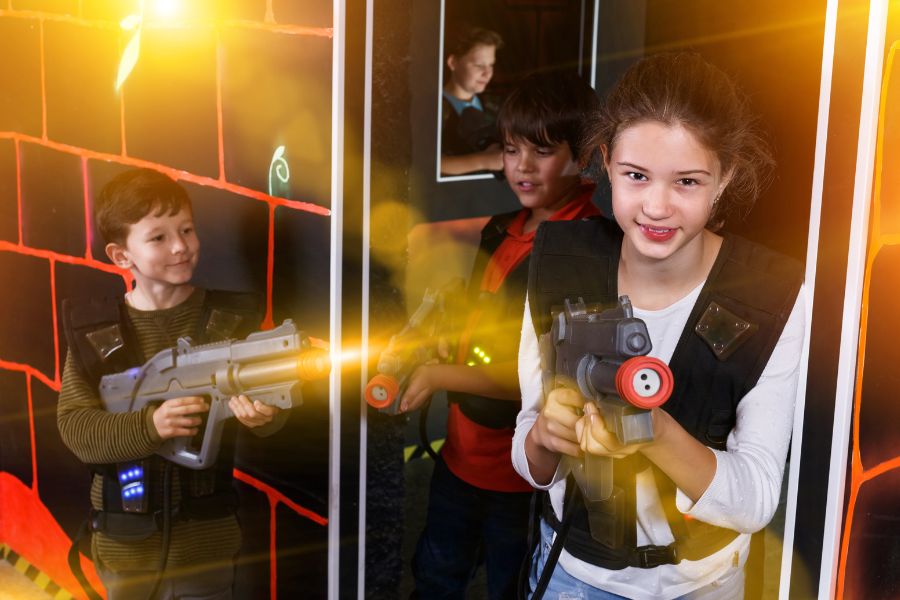As a recreational gamer with over two decades of experience in laser tag, I’ve engaged in numerous battles within both competitive arenas and home setups.
My journey into this thrilling world began more than 20 years ago when I was just a kid. It all started with a fascination sparked by my favorite movie, Star Trek, in which Captain Jean-Luc Picard uttered those famous words: “Things are only impossible until they’re not.” That moment marked the inception of my enduring passion for laser tag, a passion I’ve carried with me throughout my life.
In this article, I aim to provide you with a comprehensive overview of the laser tag game. We’ll delve into what it is, explore its intriguing history, discuss the equipment required, outline its objectives and rules, uncover effective strategies, and explain the unique qualities that make it such an exceptional and enjoyable experience.

What Is Laser Tag?
Laser tag is a captivating recreational shooting sport in which participants use toy guns that emit harmless infrared beams to tag designated targets and score points. Unlike traditional shooting sports like paintball or airsoft, there are no high-speed projectiles involved in this game, ensuring a safe and clean experience both indoors and outdoors. This means no safety equipment is necessary, and there’s no mess or residue to deal with after the match.
Think of laser tag as a real-life video game where you’re the protagonist navigating an exhilarating arena filled with challenges. To succeed, you’ll need to combine strategy, skill, and quick thinking to outsmart your opponents.
The experience is a heart-pounding adventure where you’ll find yourself creeping through the darkness, senses heightened, and adrenaline coursing through your veins. I have been playing laser tag for years, and the thrill has never faded.
The History Of Laser Tag
Over the last decade, I’ve witnessed laser tag undergo tremendous growth and evolution. It was during the late 1970s that the US Army developed the MILES (Multiple Integrated Laser Engagement) system, which utilized infrared beams for combat training. However, at that time, it was not accessible to the general public.
In 1979, coinciding with the release of Star Trek: The Motion Picture, the market saw the introduction of a captivating toy called the Star Trek Electronic Phaser Guns, as showcased in this video. This marked the debut of laser tag guns utilizing infrared light and a special sensor, introducing an entirely new level of excitement to the gaming community.
The first laser tag game incorporating a scoring system was invented by George Carter III in 1982. Just two years later, he inaugurated the Photon Center in Dallas, Texas, the world’s first commercial laser tag arena. I hold immense gratitude for this remarkable individual for bringing this recreational sport from the realm of fiction to the real world.
In 1986, various toy gun brands, including Photon Toys, Lazer Tag, Bravestarr, and Captain Power, released their own laser tag guns. Although both of these brands ceased operations relatively quickly, they left an indelible mark that continues to influence the industry, not only in the United States but also across the globe. For a comprehensive exploration of 1980s electronic laser tag games, you can refer to this video by RetroBlasting.
In the early 1990s, laser tag went through a period of decline as other forms of entertainment became more popular. However, in the late 1990s and early 2000s, a new generation of equipment was introduced, allowing for more advanced gameplay and increasing its popularity.
FUN FACT: In the famous sitcom How I Met Your Mother (2005), of which I am a big fan, the actor Neil Patrick Harris’s character, Barney Stinson, is also obsessed with this game. The show’s portrayal of laser tag helped popularize the game and brought it to the attention of a wider audience. Here’s a sneak peek:
According to IBISWorld, as of 2023, there are 1,072 laser tag centers in the USA alone, where tens of thousands of players engage in fun, parties, and recreation. Now, hundreds of brands like Kidzlane, ArmoGear, and Squad Hero manufacture the best laser tag sets, following in the footsteps of Photon.
Today, laser tag is a highly competitive sport with organized leagues and tournaments around the world. The equipment has become more technologically advanced, featuring better sensors, light, and sound effects, and even integrated video cameras that allow players to record their games.
Age Requirements
The age requirements for laser tag can differ based on the particular venue you choose to play in. While many facilities have no strict age limits, the majority set a minimum age of 6 years for participants. I personally embarked on my journey at the age of 8.
Certain venues may also impose height and weight restrictions and might mandate parental or guardian supervision for younger players. To ensure you’re well-prepared for your laser tag adventure, it’s advisable to contact the specific facility you intend to visit and inquire about their age and safety regulations. This way, you can guarantee a safe and enjoyable experience for all participants.
When it comes to playing laser tag at home, there are no age restrictions in place. The key factor is the users’ understanding of how the equipment functions and their ability to use it safely. As long as individuals meet these criteria, they are free to enjoy it in the comfort of their own space. It’s a fantastic way for families and friends of all ages to engage in this exciting game.
What Do You Need To Play Laser Tag?
Just like any recreational sport, laser tag demands the right gear for an optimal experience. While some items are essential, others fall into the optional category and are only necessary for specific situations. These include:
1. Laser Tag Guns
The heart of the game is the laser tag gun. These devices emit harmless infrared beams to ‘shoot’ opponents during a match. Those toy guns come in various shapes and sizes, often equipped with additional features such as sound and vibration effects, different firing modes, and even live displays showing game stats like health points and ammunition.
2. Vests
Every laser tag player wears a vest equipped with infrared sensors, which are strategically placed on the back, shoulders, and chest. When hit by an opponent’s infrared beam, the vest lights up or vibrates, signaling that you’ve lost a life in the game.
3. Game Control System
The game control system is like the nerve center of a laser tag game, ensuring everything runs smoothly. It’s usually comprised of a computer or tablet, enabling the game operator to initiate and conclude games, establish rules, and keep tabs on player scores and statistics.
Interestingly, for home laser tag systems, there’s no need for a separate central control unit. The vests and guns are cleverly integrated with it, streamlining the experience and making the game more accessible and user-friendly.
4. Protective Gear
Typically, you won’t require any safety gear to dive into the action. However, it’s worth noting that the need for additional protective gear can vary based on the facility and rules in place. In some cases, wearing gear like knee pads, elbow pads, or a helmet may be necessary.
This precaution is particularly common in outdoor laser tag, where the terrain might be more challenging with various obstacles. As someone who enjoys the game both in the arena and backyard, I find that each setting offers a unique and exciting experience.
5. Apparel
While laser tag doesn’t require specialized clothing like paintball, comfort is key. Wear breathable, athletic apparel that allows for free movement. Closed-toe shoes with good traction are a must to prevent accidental falls and injuries. Some players opt for camouflage clothing to blend seamlessly into the playing field.

The Objective Of Laser Tag
The objective of laser tag is straightforward and exciting. Think of it as bringing your favorite multiplayer shooter video game to life but without any real danger. Instead of using bullets, laser tag involves firing harmless infrared beams at your opponents.
In this game, you’ll start with a set number of health points. When an opponent successfully tags you with their infrared beam, you’ll lose some of these health points. When your health points reach zero, you’ll need to make your way back to your base and respawn to rejoin the action.
Playing The Game
Playing laser tag is an exciting and action-packed experience. Here’s how to get started:
- Find a Facility: Begin by locating a nearby laser tag facility. These venues are equipped with the necessary gear and provide a suitable arena for the game. Some may offer package deals for groups or parties. You can also build a home setup to play this game.
- Learn the Rules: Before you start playing, take the time to learn the rules and objectives of the game. Laser tag is all about scoring points by tagging opponents with your laser gun while avoiding getting tagged yourself.
- Enter the Arena: Once you’re geared up and familiar with the rules, step into the laser tag party. These arenas often feature dim lighting, fog, and obstacles for added excitement. Use these elements to your advantage for cover and strategic movements.
- Start Tagging: The game begins, and it’s time to start tagging opponents with your laser gun. Aim carefully, but also keep an eye out for opponents trying to tag you. Remember, teamwork and strategy can be key to success.
- Track Your Score: Many laser tag centers track scores electronically, displaying rankings on a scoreboard. Pay attention to your score and aim to accumulate as many points as possible.
- Have Fun: Most importantly, remember that laser tag is all about having fun. Enjoy the thrill of competition, the camaraderie of playing with friends and family, and the unique experience of a real-life video game in a safe and enjoyable environment.

Different Game Modes
As laser tag games gained popularity, they evolved to include a range of exciting modes inspired by video games. I’ve had the pleasure of experiencing these modes with my fellow players:
- Free for All: In this mode, it’s every player for themselves. You compete against everyone else in a battle to see who can tag the most opponents.
- Team Deathmatch: Team up with your friends or fellow players to form teams. The objective is to outscore the opposing team by tagging their members.
- King of the Hill: Similar to the video game concept, this mode involves capturing and holding a designated area within the arena to earn points for your team.
- Capture the Flag: A classic mode where teams compete to capture the opposing team’s flag and return it to their base while defending their own flag.
- Last Man Standing: In this mode, players strive to be the sole survivor. It’s a test of individual skill and strategy as you aim to outlast your opponents.
These diverse game modes add variety and excitement to the laser tag experience, ensuring there’s always a new challenge to conquer with your friends or fellow players.
Related: How Long Does A Laser Tag Game Last?
The Fundamental Rules Of Laser Tag
When it comes to laser tag, ensuring a safe and enjoyable experience for all participants is essential. While rules can vary slightly depending on the venue, here are some common guidelines to follow:
- Identify Target Areas: Typically, you can score points by tagging your opponents in four areas – the chest, shoulder, back, and their laser tag blaster itself. Every gun has a shooting range of at least 100 feet, covering almost all corners of the facility.
- No Physical Contact: Laser tag is meant to be a safe and non-contact game. Refrain from pushing or physically hitting your opponents. Avoid grabbing your opponent’s gun or attempting to snatch it away. Such actions can lead to injuries, damage to the equipment, and banning from the game.
- Movement Caution: Avoid climbing over obstacles or running during a match to prevent accidents and ensure safety.
- Proper Gun Handling: Hold your laser tag gun correctly with both hands to prevent potential injuries. Some guns won’t fire unless held properly with both hands, as they have hand sensors under the foregrip.
- Alerts: Pay attention to in-game alerts like vibrations and sounds. For example, a “dink” sound usually indicates a successful shot on an opponent, while a “dong” sound may signify friendly fire.
- Seek Assistance: Each arena typically has a dedicated administrator. Feel free to approach them if you encounter any issues or have questions during your game.
These guidelines help ensure that laser tag remains a safe and enjoyable activity for everyone involved, whether you’re playing at an arena or in a home setup with friends or family.
Strategies And Tactics
Like any other sport, making the right strategies is essential in laser tag games. Proper tactics can not only help you win the game but also ensure safety and endless fun. Here are some key strategies you should follow in the game:
- Stay Mobile: Keep moving to avoid becoming an easy target. The constant motion also helps you spot opponents more effectively.
- Use Cover: Make use of obstacles and structures in the game area to shield yourself from enemy fire.
- Team Coordination: Stick with your team and coordinate your movements. Teamwork can lead to more effective eliminations of opponents.
- Target Sensors: In most laser tag games, sensors are placed on the player’s gun and vest. Aim for these sensors to score points and eliminate opponents effectively.
- Ammo Awareness: Keep track of your ammunition and reload when necessary. Running out of ammo at a critical moment can leave you vulnerable.
- Situational Awareness: Stay alert to your surroundings to avoid surprise attacks from behind or in unexpected directions.
- Mixed Tactics: Employ a mix of offensive and defensive tactics to keep opponents guessing and gain the upper hand.
- Communication: Use hand signals or walkie-talkies to communicate with your team and coordinate your actions effectively.
- Focus and Precision: Laser tag can be fast-paced, so stay calm and focused to make accurate shots while avoiding getting tagged.
- Enjoy the Game: Above all, remember that laser tag is meant to be enjoyable, so relax and have fun!

How Safe Is Laser Tag?
Laser tag is an incredibly safe and enjoyable activity, with several advantages. Contrary to concerns, there’s no risk of eye damage because the game employs infrared beams rather than actual lasers.
The only potential risks are physical ones, like tripping or falling, which are inherent in most sports. Laser tag arenas have safety guidelines in place, so by adhering to them, you can ensure a safe experience.
Moreover, laser tag doesn’t promote violence; it’s a recreational sport that fosters teamwork and coordination. Rules, such as no pushing or physical attacks, emphasize that the objective is to have fun without causing harm.
I strongly recommend trying laser tag out, whether for yourself or with your kids. Personally, I find this sport to be an absolute blast, whether at an arena or in a home setup. So, the next time you’re looking for an exciting way to spend your free time, consider visiting an arena or creating your own experience.
Continue Learning More About Laser Tag:

